Toshiba Tecra R850: Business Class on a Budget
by Dustin Sklavos on June 6, 2011 12:01 AM ESTApplication and Futuremark Performance
I'm anxious to see how well Intel's fastest dual-core mobile Sandy Bridge performs, but the scales aren't quite as unfair this time as they were between Arrandale and Clarksfield: Sandy Bridge is a more efficient architecture, and the mobile quad-core chips scale impressively.
As Jarred has mentioned before, we've updated our benchmarking suite somewhat. PCMark05, 3DMark03, and 3DMark05 are no more. In their stead we've added PCMark 7, 3DMark 11, and Cinebench R11.5.

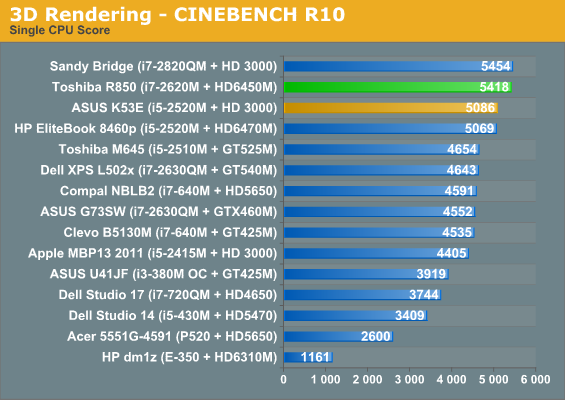
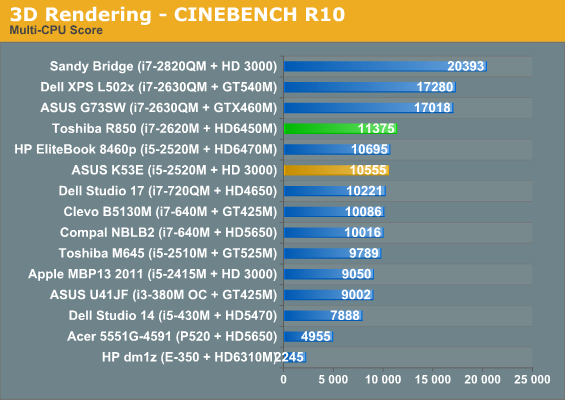
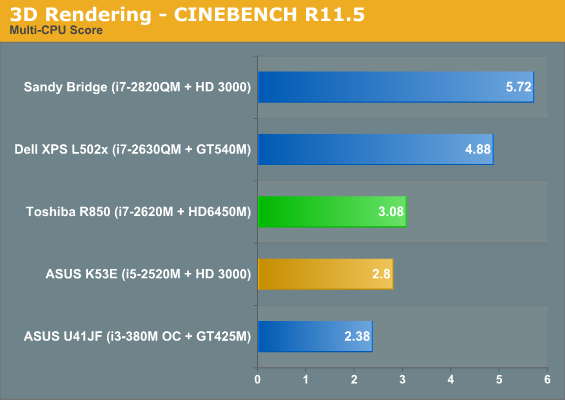
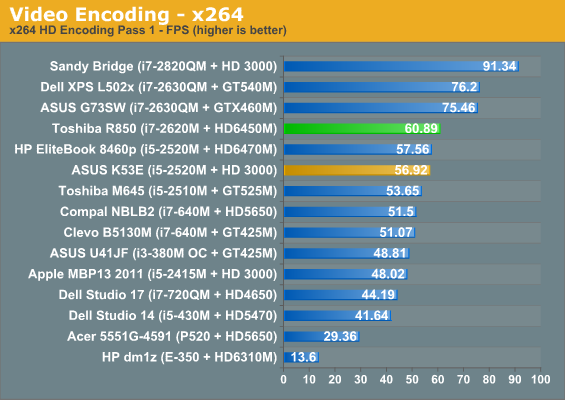
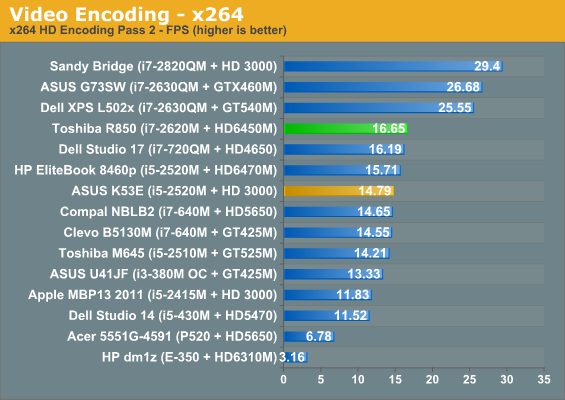
Since we don't really have any comparison points in PCMark 7 just yet, there's no sense in posting a graph with just one or two values, but the Tecra R850's score there was 1472 for reference.
As for everything else, the i7-2620M is clearly at the top of the dual-core heap, but while last generation's i7-620M and i7-720QM were able to tangle, the budget-minded i7-2630QM is generally a healthy upgrade from the 2620M--the exception being single-threaded workloads where the higher single-core puts it 17% ahead of the closest 2630QM. There are just some things a quad-core can do that a dual-core can't, and with Turbo Boost the advantages of dual-core are largely negated. Still, the Tecra R850 ranks very high on most of our charts.
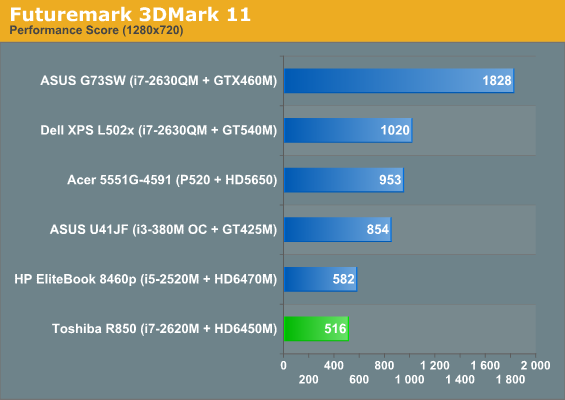
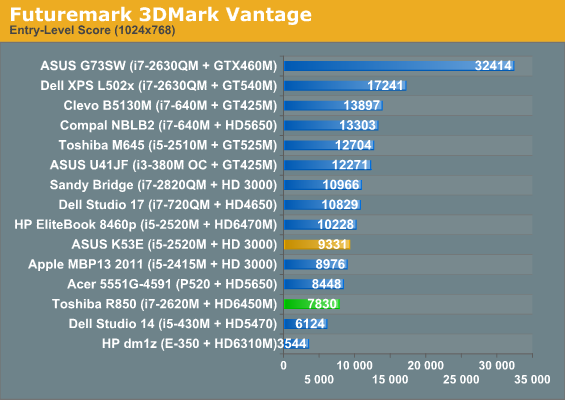
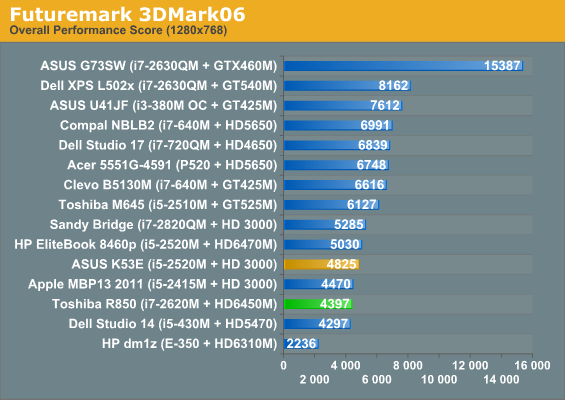
Unfortunately the Radeon HD 6450M seems to have a hard time hanging with Intel's HD 3000 integrated graphics in 3DMark, and worse, it takes a substantial performance hit from the 6470M in HP's EliteBook 8460p. Neither of these solutions are ideal, but the 150MHz deficit on the core clock going down to the 6450M hurts, and it's likely that the 200MHz deficit on the memory hurts even more so considering the 64-bit memory bus. It's worth noting that Intel still lacks support for DX11, so we can't generate a 3DMark11 score, but we'll see if 3DMark correlates with actual gaming potential next.










39 Comments
View All Comments
ScottHavens - Monday, June 6, 2011 - link
I stopped reading when I saw 15.6" and 1366x768. That resolution is borderline acceptable for a 12" screen; I'm typing this with a 1400x900 12" screen and still wouldn't mind it a bit higher res. Anything short of 1080p is laughable for a screen that size and an immediate won't-buy.kmmatney - Monday, June 6, 2011 - link
I would say that 1280 x 800 is the minimum for a 15" screen. Having only 766 vertical pixels is a crap, especially with all this ribbon-menu nonsense.TrackSmart - Monday, June 6, 2011 - link
I agree with everyone about the screen resolution and quality. Have you seen these 15.6" laptops? They are huge. Much wider than older 15" models (e.g. before 16:9 displays). Manufacturers should be going for 1680x1050 or similar resolutions and offer a higher quality screen as an upgrade for those who care. Part of the problem is that retail stores hide the screen resolution specifications. And forget about measures of screen quality. No information = no way for the non-tech savvy user to compare products. And that means no incentive for companies to give you something better.Shinobi_III - Monday, June 6, 2011 - link
My experience with Toshiba laptops has always been that while the chassis might feel real crappy, and has no "titanium trim" or branded speakers (that still sound bad)They always spent that lull money on the hardware quality, maybe not specs, but durability.
All kinds of laptops stream through my work (I fix them for a living) and Toshibas virtually never have hardware failures, unless they've been pounded on..
Guspaz - Monday, June 6, 2011 - link
I'm an r700 owner, and a friend recently purchased an r830, so I've kept up a bit on Toshiba's latest offerings. From my experience, and this review, it seems that there are a few flaws that Toshiba should fix (and should have fixed) with these second-gen laptops:1) The fingerprint reader. It's annoying that it's between the two trackpad buttons. It would be nice if it were on the palm rest on the side like other vendors do. I use the trackpad a lot, I use the fingerprint reader occasionally. Why does it need to be right on the trackpad?
2) Quad-core CPU option on larger sizes. I understand not putting a quad-core in the 830 or 840, but the 850 has no excuse. Quad-core parts don't significantly impact battery life, and the 850 clearly has thermal budget to spare. It'd be a nice upgrade if it were offered, but for some reason, it isn't.
3) The discrete graphics in the r850 are a joke. If the discrete graphics are slower than the CPU's iGPU, what the heck is the point of the discrete graphics? At least Toshiba does give you the option here to not get the ATI chip.
4) The screens. For the r700 and r830, the 1366x768 resolution isn't a huge issue. A bit low, but on a 13.3", it's still somewhat acceptable. But on a 14" or 15.6" notebook, it's really not. The review already largely touched on this, but shipping a 1366x768 15.6" display in these price ranges are not acceptable. A friend of mine was recently in the market for a ~15" dockable business notebook, and he did not purchase the r850 specifically because of the low screen resolution; his 15" Dell Latitude came with a 1680x1050 display instead, and much better quality to boot.
The unfortunate thing is that the r800 series was Toshiba's chance to fix some of the flaws from the r700 series, and it looks like they decided not to.
DaveGirard - Monday, June 6, 2011 - link
it'd be nice if you could include the MacBook Pros with discrete AMD instead of onboard graphics.Nimiz99 - Monday, June 6, 2011 - link
I just wanted to mention that for a business-class notebook 3 screens is very nice...especially considering that for mine (DELL E6410), only two screens are possible. The problem is that one of the screens that "counts" towards the limit is the laptop screen itself. Ideally i'd like to have two 23" lcd's next to each other with the laptop screen serving for email/media. The fact that the Toshiba can do that is a huge plus.On an aside, I don't think I'd spend the money on a business class notebook, where external displays, where processor speed (for all those programs and Office), and where the build quality for 50%-90% travel will make much more of a difference, when I can buy a gaming-centric note-book that delivers on the GPU and screen quality that i'd demand for that SPECIFIC usage scenario.
HangFire - Monday, June 6, 2011 - link
1366x768... sigh. I don't pay US$900 or more for 1366x768.All 15.6" laptops are big, and why not use the space for a number pad. I have no problem with that. But with the low screen resolution and poor gaming performance, you might as well buy the C655 HD3000 i3 version, which MicroCenter had on sale for Memorial Day weekend for $399.
Mxlasm - Monday, June 6, 2011 - link
I would at least mention Lenovo Thinkpads as a possible competitor. Not sure about their latest T5xx line, but in the past their business laptops always were of very high build quality, with very good keyboard and relatively light (and admittedly with a so-so scrren as well). Also usually configurable and lately reasonably priced as well.Belard - Tuesday, June 7, 2011 - link
These Toshibas don't compare to a ThinkPad T series, I'd even put them subpar to the L-Series (low-end) or even the Edge which is the "hip" modernized looking ThinkPad with island-type keyboard. But the Edge models are lower cost without the horse power.The only "feature" Toshiba has, is a numeric keypad... with a crappy keyboard.